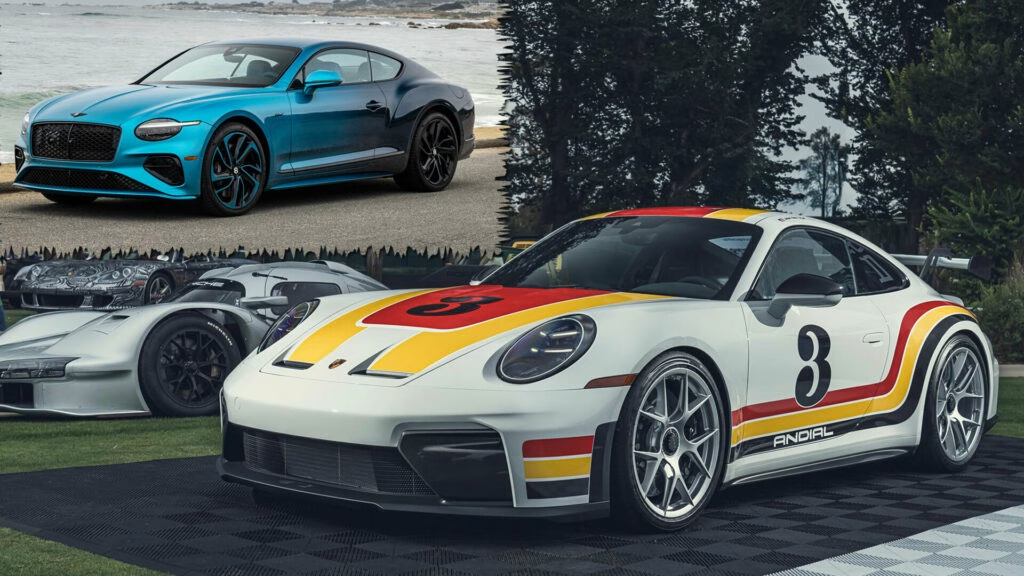What Makes Bentley’s Ombre Paint So Special?
Bentley’s new Ombre by Mulliner paint isn’t just another color option—it’s a statement. Imagine a car that subtly shifts from one rich hue to another, like a sunset melting into twilight. That’s what Bentley’s offering with this ombre finish, and it’s not something you’ll see at your local dealership anytime soon. The process is painstaking: two skilled artisans spend more than 56 hours hand-applying the paint, blending two distinct shades so seamlessly that the transition is almost magical.
This isn’t just about looking flashy. Bentley’s ombre paint is debuting on a bespoke Continental GT Speed, which starts with a sparkling Topaz at the front and gradually deepens into Windsor Blue at the rear. Even the 22-inch wheels echo this fade, with black and Topaz up front and black and Windsor Blue at the back. Step inside, and the theme continues—light blue Topaz leather up front, darker tones with Dragonfly accents in the rear, all tied together with Satin Beluga veneers and the unmistakable thump of a Naim audio system.
Why is this such a big deal? In the world of ultra-luxury cars, customization is everything. But even for Mulliner, Bentley’s in-house coachbuilder known for wild bespoke creations, this ombre effect is a technical leap. The company is limiting the ombre palette to three curated color combinations, citing the complexity of blending paints without visible seams or flaws. It’s a reminder that, sometimes, true luxury is about the things you can’t mass-produce.
How Does Porsche’s ANDIAL Livery Honor Racing Heritage?
While Bentley is all about subtle transitions, Porsche’s approach is pure nostalgia with a twist of motorsport bravado. To mark the 50th anniversary of ANDIAL—a legendary name in Porsche tuning and racing—Porsche Exclusive Manufaktur has created a retro-inspired livery for the 911 GT3. The inspiration? The iconic ANDIAL 935-L race car, a machine that dominated American tracks in the late 1970s and early 1980s.
This isn’t just a sticker pack. For $7,680, Porsche will apply a tri-color partial wrap and decal set, letting owners channel the spirit of ANDIAL’s racing heyday. You can even personalize your car with your own racing number, name, and country flag above the doors. The attention to detail goes further: the package includes a specially painted key, a matching key pouch, a custom owner’s manual case, floor mats, and door sill guards—all proudly bearing the ANDIAL logo.
For those already lucky enough to own a GT3, Porsche offers a retrofit wrap, so no one’s left out of the celebration. It’s a nod to the brand’s die-hard fans and a clever way to connect modern performance with a storied past.
What’s the Story Behind ANDIAL and Why Does It Matter?
If you’re not a Porsche enthusiast, ANDIAL might sound like just another badge. But in the world of high-performance Porsches, it’s a name that carries serious weight. Founded in 1975 by Arnold Wagner, Dieter Inzenhofer, and Alwin Springer (hence the name: AN-DI-AL), ANDIAL became synonymous with Porsche tuning in America. They weren’t just about squeezing more horsepower out of engines—they built cars that won on the track and set benchmarks for street performance.
ANDIAL’s legacy is woven into Porsche’s DNA, especially in the U.S. market. Their expertise helped shape the way American drivers experienced the brand, and their influence is still felt in Porsche’s motorsport and tuning programs today. By reviving the ANDIAL look, Porsche isn’t just selling nostalgia—they’re honoring a key chapter in their history.
How Do These Customization Options Reflect Broader Trends in Luxury Cars?
Both Bentley and Porsche are tapping into a growing appetite for personalization in the luxury car market. According to a 2023 report by McKinsey & Company, nearly 60% of luxury car buyers now expect some form of bespoke customization, whether it’s unique paint, interior finishes, or tech upgrades. Brands are responding by pushing the boundaries of what’s possible, offering everything from hand-painted finishes to heritage-inspired liveries.
But there’s a deeper trend at play: exclusivity. In an era where even high-end cars can feel mass-produced, these ultra-limited options give owners a sense of individuality. Bentley’s ombre paint, with its labor-intensive process and strict color curation, is a perfect example. Porsche’s ANDIAL livery, meanwhile, taps into the emotional connection fans have with motorsport history.
Are These Options Worth the Investment?
Let’s be honest—neither of these options comes cheap. Bentley’s ombre paint is reserved for the brand’s most discerning clients, and Porsche’s ANDIAL package costs more than some used cars. But for buyers in this segment, it’s not just about the price tag. It’s about owning something truly unique, a rolling work of art or a piece of racing heritage.
There’s also a potential upside for collectors. Limited-run finishes and heritage packages often become sought-after in the resale market, sometimes commanding a premium years down the line. It’s not a guarantee, but in the world of luxury cars, rarity and provenance count for a lot.
What’s the Real Appeal—Artistry or Exclusivity?
At the end of the day, the real draw of these offerings is the blend of artistry and exclusivity. Bentley’s ombre paint is a showcase of craftsmanship, a reminder that even in an age of automation, some things are still best done by hand. Porsche’s ANDIAL livery is a love letter to motorsport, a way for owners to feel connected to a rich racing legacy every time they hit the road.
The big takeaway? Personalization in luxury cars isn’t about perfection—it’s about smarter, more meaningful choices. Start with one detail that feels truly yours, and you’ll likely spot the difference every time you get behind the wheel.

